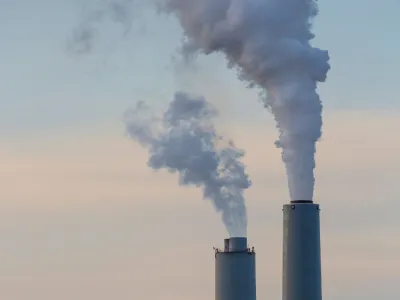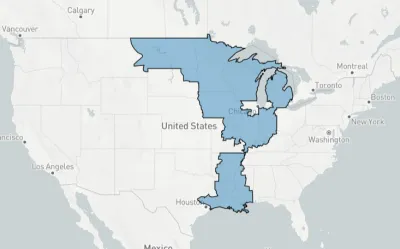Under Trump’s “energy emergency” Minnesotans may pay for a Michigan coal plant

On May 23, the Trump Administration issued an emergency order directing Michigan utility, Consumers Energy, to keep a retiring coal plant online, claiming the plant is needed to address a shortage of electric capacity in the midcontinent region. The plant was scheduled to close on May 31, 2025—one week after the DOE Order was issued. This is the first time the DOE has suspended the planned, state regulator-approved retirement of an energy generation facility.
The plant at issue is the J.H. Campbell Power Plant, a coal-fired electric generation facility in West Olive, Michigan. According to the U.S. Secretary of Energy Chris Wright, the Order “ensures that Michiganders and the greater Midwest region do not lose critical power generation capability as summer begins and electricity demand regularly reach high levels.” However, the midcontinent grid operator, MISO; Michigan utility regulators; Consumers Energy; and other stakeholders that have been assessing the planned retirement of the Campbell Plant agree—based on informed, robust analysis—that the region has plenty of generating capacity to meet customer demand.
Meanwhile, Consumers Energy is concerned about its ability to recover the costs of continuing to operate a coal plant it had long planned to retire. The utility recently filed a complaint with the Federal Regulatory Energy Commission (FERC) seeking permission to recover costs of operating the plant from ratepayers across the MISO footprint, including Minnesota. If approved, Minnesotans might see their electric bills increase to fund the operation of a coal plant located in another state that does not benefit them directly.
The Trump Administration’s order is unjustified, and it stands to increase not only air pollution but also costs to ratepayers in Michigan, Minnesota, and around the region. CUB has joined a broad chorus of public-interest advocates, large companies, utilities, and regulators opposing this action.
This article provides an overview of the circumstances surrounding this order and how it could affect Minnesotans.
What is MISO?

The Midcontinent Independent System Operator (MISO) operates the electric grid for the central United States. As described on its website, MISO “ensure[s] power flows reliably and affordably across 15 states and the Canadian province of Manitoba. Additionally, MISO facilitates the buying and selling of electricity in its region and partners with its stakeholders to plan the grid of the future.” MISO is a non-profit, independent organization overseen by the Federal Energy Regulatory Commission (FERC). Though MISO does not own electric transmission lines, it operates and coordinates the electric grid for the utilities that do own those lines. The states included in MISO’s footprint are Arkansas, Illinois, Indiana, Iowa, Kentucky, Louisiana, Michigan, Minnesota, Mississippi, Missouri, Montana, North Dakota, South Dakota, Texas, and Wisconsin.
Why did the DOE issue an emergency order?
Most decisions around energy policy are determined at the state level. The Federal Power Act provides the federal government additional powers when the country is at war or when the Secretary of Energy determines an emergency exists “by reason of a sudden increase in the demand for electric energy, or a shortage of electric energy” (among other reasons). The DOE has previously declared such emergencies during hurricanes, extreme heat events, winter storms, and blackouts.
In this instance, Secretary Wright justified the order by suggesting that not enough energy would be produced in the summer of 2025 to meet regional demand in the MISO region. The DOE based this conclusion on a May 2025 Summer Reliability Assessment issued by the North American Electric Reliability Corporation (NERC), which concluded that “MISO is at elevated risk of operating reserve shortfalls during periods of high demand or low resource output.” In other words, NERC expressed concern that there may be insufficient electricity available to meet demand across the MISO footprint during periods of peak demand—such as exceptionally hot days when a lot of businesses and households are using electricity for cooling. However, NERC later acknowledged errors in its report and revised its position to clarify that the MISO area is at an “elevated risk” but not a “high risk” over the next few years.
Who decides when a coal generation plant will be retired?
Typically, before an energy generation facility is retired the utility that owns the facility coordinates with stakeholders in the region to determine an appropriate timeline for retirement. Any such retirement is subject to the review and approval of the applicable state utility regulator. That regulatory decision takes many factors into account, including impacts to labor and host communities where the plant is located, consumer energy costs, reliability of service, and compliance with state and federal energy laws. Planning for such a retirement involves extensive review, modeling and analysis, and input from stakeholders affected by the decision.
In Minnesota, Michigan, and many other states, regulated electric utilities are required by law to file integrated resource plans (IRPs) every few years. At root, an IRP provides a roadmap for how a utility plans to meet its electricity demand in the future. IPRs are iterative: they evolve as electric supply and demand evolves, and as state and federal energy policy and legislation changes. A utility’s plan must specify how it will generate or procure electricity, including from existing generation facilities it owns and new facilities it intends to build. When a utility proposes to retire a coal plant, its IRP filings will explain the utility’s plans for replacing the electricity generated by the plant in order to ensure the utility is able to meet projected demand.
In Michigan, 29 separate parties participated in Consumers Energy’s last IRP. As part of a settlement agreement resolving the IRP, the parties agreed that it was appropriate to retire the Campbell plant in 2025. The settlement also included a number of measures to ensure energy service would remain reliable in Michigan without the Campbell Plant. The Michigan Public Service Commission issued an order on June 23, 2022 approving the settlement agreement, including the planned retirement of the Campbell Plant. The DOE Emergency Order ignores and overrides all of this work and analysis, and the years of planning that followed, to needlessly extend the operation of the Campbell Plant.
Who will pay for the Campbell plant?
After the DOE issued its Order requiring the continued operation of the Campbell Plant, Consumers Energy became understandably concerned about whether and how it could recover the costs of operating the plant. Specifically, Consumers Energy was concerned that Michigan regulators would not permit Consumers Energy to charge its customers for the operation of a generation facility that is no longer needed. In an attempt to address this, Consumers Energy filed a complaint with FERC requesting changes to cost recovery mechanisms to allow Consumers Energy to socialize the costs of operating the Campbell Plan across the entire MISO footprint, including Minnesota.
How might Minnesotans be affected by the DOE’s Emergency Order?
First and foremost, if Consumers Energy’s request is approved, Minnesotans could be forced to pay for a coal plant in Michigan whose continued operation is not needed and does not benefit Minnesotans. This would be exceedingly frustrating at a time when many Minnesotans are already struggling to pay their utility bills.
Second, if the DOE’s efforts to subvert state regulatory decisions are successful in this instance, the DOE might issue additional orders forcing the continued operation of other coal plants that have long been scheduled for retirement. (Indeed, such actions would be consistent with President Trump’s numerous statements about reviving the nation’s coal industry.) Minnesota Power and Xcel are both in the process of retiring coal facilities in Minnesota, informed by many years of ongoing scrutiny, review, and debate by numerous parties appearing before the Minnesota Public Utilities Commission (PUC). If those plants now continue operating beyond their scheduled retirement date, Minnesota utilities will likely seek to recover the costs of such operation from their customers—along with the costs of building and operating new resources long-planned to replace the retiring coal plants.
What are state regulators and advocates doing about this?
Several state agencies, consumer advocates, and environmental advocates across the MISO region have objected to the DOE order and/or Consumers Energy’s cost recovery request. For example:
On June 18, a group of environmental and public interest organizations filed a legal motion contending that DOE’s emergency order was illegal and not based on any actual emergency.
On June 20, CUB filed to intervene in the FERC docket addressing Consumers Energy’s request to recover costs of the Campbell Plant from consumers across the MISO footprint. We also joined several other consumer and environmental advocates in filing comments with FERC raising concerns about the impacts of the DOE order. This is unusual for CUB: it is only the second time in our organization’s history that we have intervened in a docket at the federal level.
On June 23the Organization of MISO states (OMS) filed a legal motion contending the DOE’s emergency order was illegal and asking for a rehearing. OMS is a non-profit, self-governing organization representing the collective interests of 15 state utility regulators, the New Orleans City Council, and the Canadian province of Manitoba and serves as the regional state committee for the MISO region. A majority of OMS members, including the Minnesota Public Utilities Commission, voted to challenge the DOE emergency order.
How can you get involved?
We believe it is highly important for Minnesotans to be represented in this particular matter. Minnesotans should not be forced to pay for the operation of a coal plant that is not needed and that will not benefit Minnesotans—particularly when numerous entities have spent countless hours navigating state regulatory processes planning to retire coal plants in ways that will not disrupt the reliability of the energy grid.
Unfortunately, there is not currently an opportunity to file public comments in the FERC docket—though such an opportunity may arise in the future. Keep an eye on our website for additional updates on this matter.